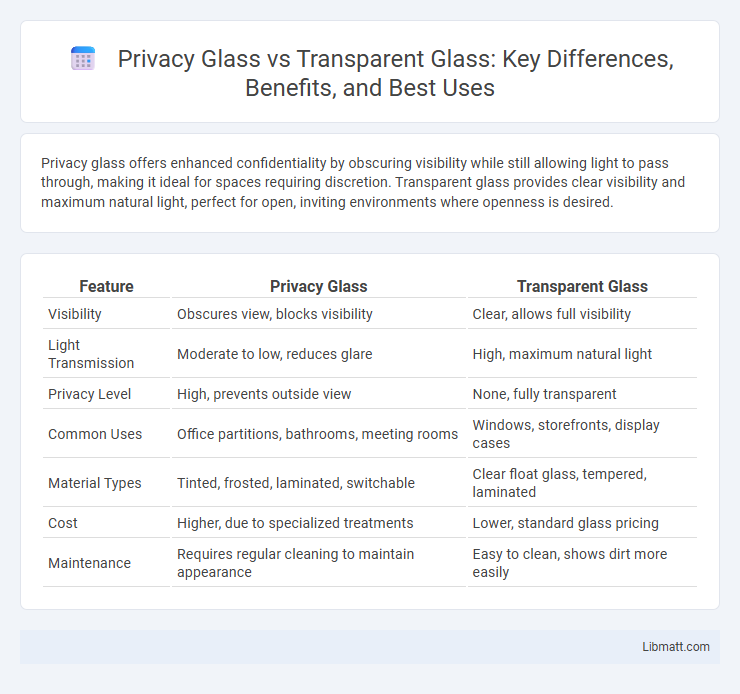Privacy glass offers enhanced confidentiality by obscuring visibility while still allowing light to pass through, making it ideal for spaces requiring discretion. Transparent glass provides clear visibility and maximum natural light, perfect for open, inviting environments where openness is desired.
Table of Comparison
| Feature | Privacy Glass | Transparent Glass |
|---|---|---|
| Visibility | Obscures view, blocks visibility | Clear, allows full visibility |
| Light Transmission | Moderate to low, reduces glare | High, maximum natural light |
| Privacy Level | High, prevents outside view | None, fully transparent |
| Common Uses | Office partitions, bathrooms, meeting rooms | Windows, storefronts, display cases |
| Material Types | Tinted, frosted, laminated, switchable | Clear float glass, tempered, laminated |
| Cost | Higher, due to specialized treatments | Lower, standard glass pricing |
| Maintenance | Requires regular cleaning to maintain appearance | Easy to clean, shows dirt more easily |
Introduction to Privacy Glass and Transparent Glass
Privacy glass, often used in automotive and architectural applications, features a tinted or frosted surface that reduces visibility from outside while allowing light to pass through. Transparent glass offers maximum clarity and light transmission, providing an unobstructed view that prioritizes openness and visibility. Your choice between privacy and transparent glass depends on the balance you seek between light, visibility, and confidentiality.
Understanding How Privacy Glass Works
Privacy glass, also known as switchable or smart glass, utilizes embedded micro-louvers or liquid crystal technology to control light transmission and visibility, allowing it to shift from transparent to frosted or opaque states. Unlike transparent glass, which allows unrestricted visibility and light passage, privacy glass can block views while maintaining natural light, enhancing confidentiality in residential, automotive, and commercial applications. This dynamic control of light and visibility relies on electrical currents or micro-structures that manipulate the alignment of molecules within the glass, ensuring user-controlled privacy without compromising illumination.
Key Features of Transparent Glass
Transparent glass offers maximum clarity and light transmission, making it ideal for spaces that require natural daylight and clear visibility. It is typically made from high-quality silica and can be coated to enhance features like UV protection or scratch resistance. Common applications include windows, glass doors, and storefronts where aesthetics and openness are prioritized.
Benefits of Choosing Privacy Glass
Privacy glass offers superior heat reduction and UV protection compared to transparent glass, enhancing comfort and energy efficiency in vehicles and buildings. It provides increased security by obscuring the interior from outside view, reducing the risk of theft and enhancing personal privacy. This type of glass also minimizes glare, improving visibility and reducing eye strain in bright conditions.
Advantages of Transparent Glass in Modern Design
Transparent glass in modern design enhances natural light penetration, creating bright and inviting spaces that improve mood and productivity. Its clarity offers unobstructed views, connecting indoor environments with the outdoors and fostering a sense of openness. Additionally, transparent glass supports energy efficiency by optimizing passive solar heating and reducing the need for artificial lighting.
Privacy Glass vs Transparent Glass: Aesthetic Differences
Privacy glass offers a sleek, tinted appearance that enhances vehicle aesthetics by providing a modern, understated look, while transparent glass maintains clear visibility and a traditional, open feel. The darker shade of privacy glass reduces glare and adds a sense of exclusivity to the design, in contrast to the bright, unobstructed view provided by transparent glass. Your choice between the two can significantly impact the visual style and ambiance of your vehicle or space.
Energy Efficiency: Comparing Glass Types
Privacy glass features a tinted or coated composition that reduces solar heat gain, enhancing energy efficiency by minimizing the need for air conditioning. Transparent glass, while allowing maximum natural light, often results in higher heat transfer and increased cooling costs. Energy-efficient privacy glass can contribute to lower utility bills and improved indoor comfort in buildings with significant sun exposure.
Security and Safety Considerations
Privacy glass enhances security by obscuring visibility into your vehicle or space, deterring potential theft or vandalism through limited line of sight. Transparent glass, while offering clear visibility, may increase vulnerability to break-ins as valuables are more easily seen, yet it allows for quick assessment of hazards or emergencies. Choosing privacy glass can improve safety by reducing risk exposure and protecting personal belongings from outside view without compromising structural integrity.
Cost Comparison: Privacy Glass vs Transparent Glass
Privacy glass typically costs 20-30% more than transparent glass due to its specialized tinting or electrochromic technology that enhances privacy and reduces glare. Transparent glass is more affordable and widely used, but it lacks the light control and privacy benefits that privacy glass offers. Your choice depends on budget constraints and the value you place on privacy and energy efficiency.
Choosing the Right Glass for Your Space
Privacy glass enhances interior spaces by obscuring visibility while allowing natural light to pass through, ideal for bathrooms, offices, and conference rooms requiring discretion. Transparent glass offers clear views and maximal daylight, making it the preferred choice for areas prioritizing openness and visibility, such as living rooms or storefronts. Selecting the right glass depends on balancing privacy needs with light transmission, ensuring functionality and aesthetic harmony in your design.
Privacy glass vs transparent glass Infographic

 libmatt.com
libmatt.com